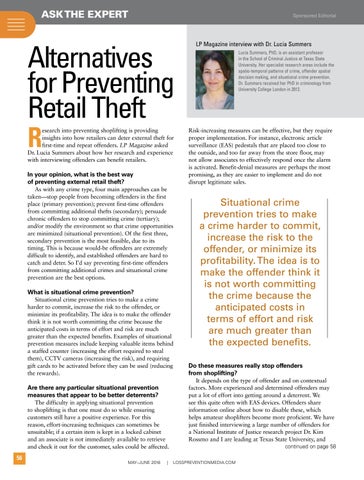Ask the expert
Sponsored Editorial
Alternatives for Preventing Retail Theft R
esearch into preventing shoplifting is providing insights into how retailers can deter external theft for first-time and repeat offenders. LP Magazine asked Dr. Lucia Summers about how her research and experience with interviewing offenders can benefit retailers.
In your opinion, what is the best way of preventing external retail theft? As with any crime type, four main approaches can be taken—stop people from becoming offenders in the first place (primary prevention); prevent first-time offenders from committing additional thefts (secondary); persuade chronic offenders to stop committing crime (tertiary); and/or modify the environment so that crime opportunities are minimized (situational prevention). Of the first three, secondary prevention is the most feasible, due to its timing. This is because would-be offenders are extremely difficult to identify, and established offenders are hard to catch and deter. So I’d say preventing first-time offenders from committing additional crimes and situational crime prevention are the best options.
What is situational crime prevention? Situational crime prevention tries to make a crime harder to commit, increase the risk to the offender, or minimize its profitability. The idea is to make the offender think it is not worth committing the crime because the anticipated costs in terms of effort and risk are much greater than the expected benefits. Examples of situational prevention measures include keeping valuable items behind a staffed counter (increasing the effort required to steal them), CCTV cameras (increasing the risk), and requiring gift cards to be activated before they can be used (reducing the rewards).
Are there any particular situational prevention measures that appear to be better deterrents? The difficulty in applying situational prevention to shoplifting is that one must do so while ensuring customers still have a positive experience. For this reason, effort-increasing techniques can sometimes be unsuitable; if a certain item is kept in a locked cabinet and an associate is not immediately available to retrieve and check it out for the customer, sales could be affected.
56
may–june 2016
|
LP Magazine interview with Dr. Lucia Summers Lucia Summers, PhD, is an assistant professor in the School of Criminal Justice at Texas State University. Her specialist research areas include the spatio-temporal patterns of crime, offender spatial decision making, and situational crime prevention. Dr. Summers received her PhD in criminology from University College London in 2012.
Risk-increasing measures can be effective, but they require proper implementation. For instance, electronic article surveillance (EAS) pedestals that are placed too close to the outside, and too far away from the store floor, may not allow associates to effectively respond once the alarm is activated. Benefit-denial measures are perhaps the most promising, as they are easier to implement and do not disrupt legitimate sales.
Situational crime prevention tries to make a crime harder to commit, increase the risk to the offender, or minimize its profitability. The idea is to make the offender think it is not worth committing the crime because the anticipated costs in terms of effort and risk are much greater than the expected benefits. Do these measures really stop offenders from shoplifting? It depends on the type of offender and on contextual factors. More experienced and determined offenders may put a lot of effort into getting around a deterrent. We see this quite often with EAS devices. Offenders share information online about how to disable these, which helps amateur shoplifters become more proficient. We have just finished interviewing a large number of offenders for a National Institute of Justice research project Dr. Kim Rossmo and I are leading at Texas State University, and continued on page 58
LOSSPREVENTIONMEDIA.COM
